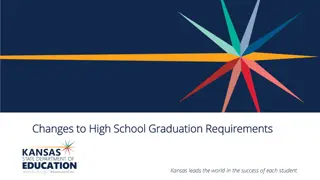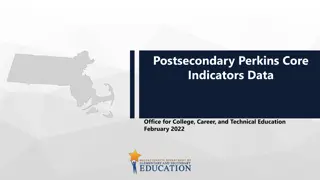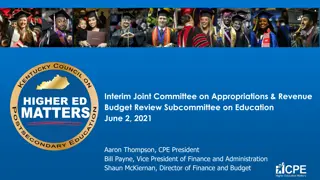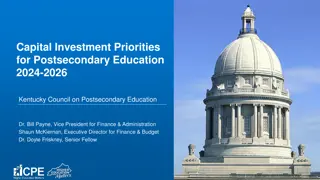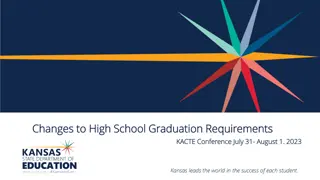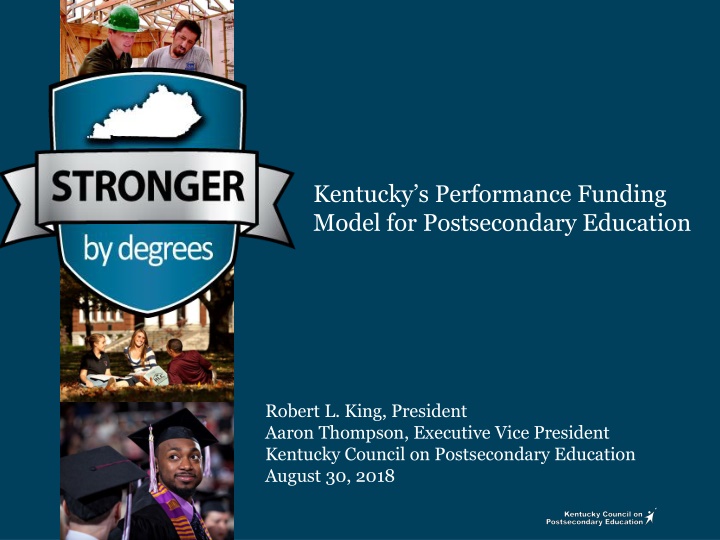
Kentucky's Performance Funding Model for Postsecondary Education Implementation
Learn about Kentucky's innovative performance funding model for postsecondary education, which replaced the outdated incremental budgeting approach. The development process, consensus achieved, and state goals focused on improving student outcomes and aligning incentives with desired state objectives. Discover how this model encourages campus performance, mission alignment, and enrollment growth to support student success and workforce development in high-demand fields.
Download Presentation

Please find below an Image/Link to download the presentation.
The content on the website is provided AS IS for your information and personal use only. It may not be sold, licensed, or shared on other websites without obtaining consent from the author. If you encounter any issues during the download, it is possible that the publisher has removed the file from their server.
You are allowed to download the files provided on this website for personal or commercial use, subject to the condition that they are used lawfully. All files are the property of their respective owners.
The content on the website is provided AS IS for your information and personal use only. It may not be sold, licensed, or shared on other websites without obtaining consent from the author.
E N D
Presentation Transcript
Kentuckys Performance Funding Model for Postsecondary Education Robert L. King, President Aaron Thompson, Executive Vice President Kentucky Council on Postsecondary Education August 30, 2018
Previous Distribution Method State appropriations were distributed based on share of funding received the prior year Incremental budgeting approach that applied base plus (or base minus) methodology This approach failed to recognize changes in: Enrollment Program mix Student outcomes (progression, degree completion) No financial incentives for achieving desired state goals for postsecondary education 2
Development Process The 2016 budget bill (HB 303) directed the Council to establish a working group composed of: The Governor (or representative) President of Senate (or representative) Speaker of the House (or representative) President of each public university and KCTCS Council president Charged with developing a comprehensive model for allocating state appropriations that incorporates: Campus performance Mission Enrollment 3
Development Process (Contd) The working group met five times between April and November 2016 Report recommendations were endorsed by presidents and submitted to Governor and IJCE on December 1 Formed basis for SB 153, introduced February 2017 It passed the House and Senate with no changes and was signed into law by Governor on March 21, 2017 (KRS 164.092) Creating the model required compromise on part of every institution, ultimately consensus was achieved 4
State Goals (Get Better Faster) Increase retention and progression of students toward timely completion Increase numbers of degrees and credentials earned by all student types Produce more degrees and credentials that garner higher wages upon completion: STEM+H fields high demand fields and targeted industries Close achievement gaps by growing numbers of degrees and credentials earned by minority, low income, and underprepared students 6
Model Components Kentucky's Performance Funding Model Distribution of Allocable Resources Student Success 35% Course Completion 35% Share of credit hours earned (weighted for cost differences by course level and discipline) Share of student success outcomes produced Maintenance and Operations 10% Share of facilities square feet dedicated to student learning Academic Support 10% Share of full-time equivalent (FTE) student enrollment Institutional Support 10% Share of spending on instruction and student services 7
Student Success Metrics Universities Bachelor s degrees earned Degrees per 100 FTE students Bachelor s degrees earned in: STEM+H Fields Bachelor s degrees earned by: URM Students Low Income Students Progression(@ 30, 60, 90 Credit Hours) KCTCS (will be presented by KCTCS President Jay Box) 8
Component Funding Pools Kentucky Performance Funding Model Major Components, Allocation Percentages, and Funding Pools Fiscal 2018-19 (Dollars in Millions) Allocation Percentages Component Funding Pools Model Component Distribution Method Share of student success outcomes produced Student Success 35% $181.9 Share of weighted student credit hours earned Course Completion 35% 181.9 Share of facilities square feet dedicated to student learning Maintenance and Operations 10% 52.0 Share of spending on instruction and student services Institutional Support 10% 52.0 Academic Support 10% 52.0 Share of FTE student enrollment Total Allocable Resources 100% $519.8 9
Student Success Funding Pools Kentucky Performance Funding Model Success Metrics, Allocation Percentages, and Funding Pools Fiscal 2018-19 (Dollars in Millions) Allocation Percentages Student Student Success Metric Success Pool Progression @ 30 Hours 3% $15.6 Progression @ 60 Hours 5% 26.0 Progression @ 90 Hours 7% 36.4 Bachelor's Degrees 9% 46.8 STEM+H Degrees 5% 26.0 URM Bachelor's Degrees 3% 15.6 Low Income Bachelor's Degrees 3% 15.6 Total Student Success Allocable Resources 35% $181.9 10
Bachelors Degree Distribution Kentucky Performance Funding Model Distribution of Bachelor's Degree Component Funds Fiscal Year 2018-19 Bachelor's Degree Pool $46,784,400 Weighted Bachelor's Degrees Degree Share Funding Distribution 1 Institution University of Kentucky University of Louisville Eastern Kentucky University Kentucky State University Morehead State University Murray State University Northern Kentucky University Western Kentucky University 7,286 4,843 2,651 307 1,188 1,694 2,285 2,721 31.7% 21.1% 11.5% 1.3% 5.2% 7.4% 9.9% 11.8% $14,836,200 9,861,800 5,397,400 626,100 2,418,800 3,449,100 4,653,900 5,541,100 Total 22,975 100.0% $46,784,400 1Three-year rolling average of bachelor's degrees produced, weighted to promote efficient degree production through use of a degrees per 100 FTE student index and to account for cost and mission differences between the research and comprehensive sectors. 11
Pursuing Equilibrium (Bachelors Degrees) Kentucky Performance Funding Model Bachelor's Degree Component Funding per Weighted Bachelor'sDegree Fiscal Year 2018-19 $4,500 Pool Size = $46.8 M $3,958 $4,000 State Funding per Bachelor's Degree $3,500 $3,000 $1,922 2018-19 Distribution Achieves Equilibrium at Six Institutions $2,500 $2,237 $201 $2,000 $2,036 $2,036 $2,036 $2,036 $2,036 $2,036 $2,036 $2,036 $1,500 $1,000 $500 $0 UK UofL EKU MuSU NKU WKU MoSU KSU 12 Bachelor's Funding per Bachelor's Degree Hold Harmless Allocation per Bachelor's Degree
Premiums for Underserved Populations Kentucky Performance Funding Model Premiums for Low Income and Minority Student Degree Production Fiscal Year 2018-19 Allocation Component Category Percent Weighted Degrees State Funding per Degree Funding Multiple Size of Pool Bachelor's Degrees 9.0% $46,784,400 22,975 $2,036 1.0 Bachelor's Degrees Low Income Bachelor's $2,036 1,344 3.0% $15,594,800 11,606 Low Income Total $3,380 1.7 Bachelor's Degrees Minority Bachelor's $2,036 6,471 3.0% $15,594,800 2,410 Minority Total $8,507 4.2 Total Allocable Resources: $519,827,100 13
Gradual Phase In Fiscal 2017-18 Distribute $42.9 M Performance Fund (KSU Excluded from Model) Fiscal 2018-19 Hold Harmless Maximum Possible Redistribution 3% Over 3 Years Fiscal 2019-20 1% Stop Loss Fiscal 2020-21 2% Stop Loss (Reconvene Working Group) 14
Impact on Institutions State funding is no longer being distributed based on historical share Funding based on outcomes provides incentives for student progression and timely completion Most of the funding disparities that developed over time have been rectified With the exception of two institutions, equilibrium has been achieved within university funding model Less productive institutions could see a portion of their funding shift to others beginning in 2019-20 15
Detailed Attributes Backs out research and public service appropriations that are not instruction related Removes $4.5 M from formula at each comprehensive university as a small school adjustment Weights student credit hours earned to account for cost differences by degree level and discipline Applies 50% weighting for credit hours earned by out-of-state students (100% for in-state students) Uses degrees per 100 FTE index to encourage efficient degree production Area of Compromise 16
Detailed Attributes (Contd) Provides premiums for degrees earned by low income and minority students Provides premiums for degrees earned in STEM+H and high demand fields Distributes state funds based on share of outcomes produced (i.e., provides like funding for like activities) Uses hold harmless and stop loss provisions to provide gradual phase in (max 3% over 3 years) Rewards percent growth above the sector average, once equilibrium is achieved Area of Compromise 17
Small School Adjustment ($4.5 M each) Kentucky ComprehensiveUniversity Funding Model Deductions as a Percent of General Fund Appropriations Fiscal Year 2018-19 WKU 6% 8% 86% EKU 7% 3% 89% NKU 9% 3% 88% MuSU 10% 7% 83% MoSU 11% 7% 81% KSU 17% 26% 56% 0% 10% 20% 30% 40% 50% 60% 70% 80% 90% 100% 18 Small School Adjustment Mandated Programs Allocable Resources
Credit Hour Weights Weighted Average Instruction Costs per Credit Hour By Course Level and Discipline (Average of FL, IL, & OH Cost Studies) Student Credit Hour Cost Indices by Discipline and Level Course Level Discipline Lower Division Upper Division Master's Other Graduate Doctoral I Doctoral II Liberal Arts, Math, Social Sciences Basic Skills Business Education Service Visual and Performing Arts Trades and Technologies Sciences Law Engineering/Architecture Health Nursing Other 1.07 1.00 1.00 1.17 1.06 1.36 1.45 1.18 1.52 1.57 1.44 1.44 1.00 1.48 1.22 1.44 1.47 1.22 2.24 1.97 1.86 1.25 2.52 1.76 1.76 1.22 3.27 2.19 2.68 2.32 2.19 4.49 2.95 4.70 3.33 4.37 4.13 4.13 2.19 3.27 2.19 2.68 2.32 2.19 4.49 2.95 4.70 3.33 4.37 4.13 4.13 2.19 3.81 3.17 5.42 3.28 3.17 4.50 3.62 4.74 4.47 4.47 4.66 4.66 3.17 4.34 4.16 8.17 4.24 4.16 4.51 4.30 4.79 5.61 4.58 5.19 5.19 4.16 Note: Indices calculated by dividing the cost per credit hour for each category by the cost per credit hour of the lowest cost category. Source: SHEEO Four-State Cost Study. 19
Serving Low Income Students Kentucky PublicFour-Year Institutions Low Income Student Bachelor'sDegrees Produced AcademicYear 2016-17 Percent of Cohort with Pell Number of Degrees 1,800 90% Total Low Income Bachelor's Degrees = 8,167 1,600 80% 1,494 1,399 1,400 70% 1,276 1,203 66% 1,200 60% 1,040 1,000 50% 51% 775 47% 743 800 40% 37% 37% 36% 600 30% 31% 400 20% 24% 237 200 10% 0 0% UK UofL EKU KSU MoSU MuSU NKU WKU Low Income Bachelor's Degrees Percent of Full-Time First-Time Undergraduates Awarded Pell 20 Sources: Low Income Degree Data, CPE Comprehensive Database; Fall 2015 Cohort Data, IPEDS.
Serving Minority Students Kentucky PublicFour-Year Institutions Underrepresented Minority Student Bachelor'sDegrees Produced AcademicYear 2016-17 Percent of Cohort Minority Number of Degrees 900 90% Total Minority Bachelor's Degrees = 2,401 800 80% 75% 700 70% 594 577 600 60% 500 50% 400 40% 310 300 30% 246 213 182 174 200 20% 105 19% 18% 100 10% 15% 15% 13% 10% 9% 0 0% UK UofL EKU KSU MoSU MuSU NKU WKU Minority Student Bachelor's Degrees Percent of Full-Time First-Time Undergraduates Who Are Minority 21 Sources: Minority Degree Data, CPE Comprehensive Database; Fall 2015 Cohort Data, IPEDS.
Performance Distribution (2018-19) Kentucky Performance Funding Model Distribution of Postsecondary Education Performance Funds Fiscal Year 2018-19 Institution Distribution University of Kentucky University of Louisville Eastern Kentucky University Kentucky State University Morehead State University Murray State University Northern Kentucky University Western Kentucky University KCTCS $9,119,000 2,507,100 3,387,300 0 0 557,800 4,837,200 3,748,600 6,843,000 Total $31,000,000 The enacted budget for 2018-20 (HB 200) appropriated $31.0 million to the Postsecondary Education Performance Fund in fiscal year 2018-19. These funds are being distributed among institutions according to provisions of SB 153 (2017). 22
Model Rewards Growth in Outcomes Kentucky Performance Funding Model Metrics Where Rates of Growth Exceeded Sector Average Between Fiscal Years 2017-18 and 2018-19 Performance Metric Student Success Outcomes Bachelor's Degrees STEM+H Bachelor's Degrees URM Bachelor's Degrees Low Income Bachelor's Degrees Student Progression @ 30 Hours Student Progression @ 60 Hours Student Progression @ 90 Hours Earned Credit Hours Operational Support Activity Instructional Square Feet Direct Cost of Instruction FTE Students UK UofL EKU KSU MoSU MuSU NKU WKU Metrics Above Sector Average 11 6 5 3 5 4 2 1 23
How to Win in the Model Enroll and retain greater numbers of academically qualified degree seeking students Encourage students to take full course loads and provide support services to help them progress to timely completion Increase graduation rates and produce more degrees, especially among underserved student populations or in areas of pressing state need Beat the sector average 24
Model Advantages Rational Comprehensive Dynamic Fair 25
Kentuckys Performance Funding Model for Postsecondary Education Robert L. King, President Aaron Thompson, Executive Vice President Kentucky Council on Postsecondary Education August 30, 2018

